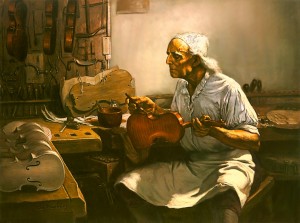An Invincible Violinist knows that beginning the journey with the right instrument is important. The “I’ll get a Suzy a good violin if and when she sticks with it” approach in not doing your young student any favor.
Before you buy a violin, answer these questions:
- If you are just starting, do you need a violin right away? Many teachers of young students will start their pupils using a lightweight “mock violin” instead of the real thing. In this case, the teacher will likely be your best source of information on size, budget.
- Do you have access to a speciality violin shop in your area that rents instruments? If so, you’ll generally get a much better instrument in a ready to play condition. Many off-the-shelf violins bought at generalist music stores and online will be of marginal quality. Again, an experienced teacher or player is a great resource.
Rent a Violin, Don’t Buy
There are plenty of reasons to rent. A five year old will quickly outgrow the fractional size “kiddie size” instruments, and will probably need a larger instrument every year or two.
When you are ready for your “forever” instrument, chances are you’ll want to select it from among many sources. Sometimes, a rent-to-buy program might save you some cost on that final purchase. Just be sure to rent from a dedicated violin shop that offers high quality student and artist level instruments.
When It’s Time to Buy Your Violin
Violin shopping (online or in person) is an exciting time for any student. It can also be very confusing. Here are some tips to simplify the process:
- Always buy where you have a trial period with a return privilege.
- Take an experienced violinist friend along to the shop. You’ll get added feedback about how an instrument sounds across the room. Or, your friend can play the instrument for you to hear.
What Size Violin is Correct
Playing a violin that’s too large can be crippling at worst, and will slow down your progress, at best. Beyond the size, the excessive weight is a burden on the player. By the same token, a tiny fractional size instrument won’t be playable by a player who has outgrown it. Her fingers and arms will be hopelessly “mashed” together.
Small instruments also come with a small tone. They force the player to work harder, which is not a good thing!
Still, when in doubt it’s best to err on the side of too small, rather than too large.
Sizing is accomplished using one of these methods:
- A size chart based on age. Not accurate at all.
- Violin Size Chart matching an actual instrument to a player’s arm length.
- Using Method 2, tempered by the experience of a teacher.
Obviously, an experienced teacher should be your guide whenever possible.
If all of this hasn’t convinced you to buy or rent a perfectly sized instrument consider this:
If you are trying to save money by playing a full size instrument before you are ready for it, you’ll like spend what you’ve saved on the instrument on lessons to fix the technical problems that will result.
A wrong size violin costs you time, money and bad playing habits.
Bottom line here: rent or buy the best instrument you can afford. Always be sure it is sized correctly. Seek out impartial advice.
Don’t forget the Bow
Many students and families overlook the importance of a quality bow. That’s a serious mistake; bow selection is equally important as choosing the right instrument.
Just as with the violin, be sure to ask for an approval period. Avoid shopping for violin and bow at the same time. You’ll want to select a bow based on how it feels on your permanent instrument. It’s amazing how a bow can enhance the sound of your violin!
Often bows are included with an instrument purchase; the quality varies widely. Generally speaking, it’s best to select the bow on its own merits. Keep the “freebie” bow in your case. It’s always great to have a spare bow.
—
If you find this information helpful, please share or tweet this page or post, using the buttons below. Thanks!

